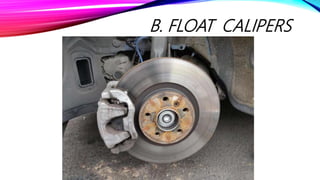Lesson - Component Parts of Braking System.pptx
- 1. TOYOZU TECHNICAL SCHOOL FOUNDATION, INC. ATS NC II TRAINING SESSION Batch 2021
- 2. OPENING PRAYER Lord, help us in our online studies today. Give us concentration so that may we listen, understand, learn and have peaceful mind and may we always remember that god is always with us
- 3. GOOD MORNING! TTSFI ATS NC II TRAINEES
- 4. LESSON: COMPONENT PARTS OF BRAKING SYSTEM
- 5. ATS NC II TRAINING SESSION Objectives: ? Identify the component parts of braking system
- 6. LESSON: COMPONENT PARTS OF BRAKING SYSTEM
- 9. INTRODUCTION All cars have several systems. They are mandatory, and they will be present as long as cars exist. One of them is your brake system. Brake system components may vary depending on the make and model, but generally, they work in the same principle.
- 10. INTRODUCTION Today we will help you understand all about the components and why they are important. Your brake system must be in perfect condition 24/7/365. The following are the parts of your vehicle's hydraulic brake system.
- 13. 1. BRAKE PEDAL It is the pedal that you press with your foot in order to make a vehicle go slower or stop. The brake pedal is located on the floor to the left of the accelerator.
- 18. 2. HYDRO-VAC POWER BOOSTER It provides additional force to the brake pedal which result of easily acquired pressure needed to apply brake. These vacuum booster receives via a vacuum system attached to the engine’s intake manifold (Gasoline Engine) or alternator (Diesel Engine).
- 23. 3. BRAKE MASTER CYLINDER It is located in the engine compartment on the firewall. It consists of fluid which compensates for any change in fluid volume in the pipe line. When sufficient pressure has build up, the inner rubber cup is deflected, forcing the fluid in the lines, thereby it applying brakes.
- 27. 4. BRAKE FLUID It is a special oil with some specific properties. It can withstand cold temperature without thickening as well as very high temperature without boiling. The current standard is DOT-3 (Department of Transportation) which has a boiling point of 460oF.
- 30. 5. FLUID LINES These are the series of steel tubes and rubber hoses through which brake fluid travels. Rubber hoses are used only in places that requires flexibility such as front wheels. Its dangerous to use brass fittings or tubing to repair brake lines.
- 34. 6. COMBINATION VALVE It is combination of proportioning valve and pressure differential valve
- 37. A. PROPORTIONING VALVE These are mounted between the master cylinder and rear wheels which adjusts the pressure between the front and rear brakes.
- 40. B. PRESSURE DIFFERENTIAL VALVE It mounted just below the master cylinder, it measures the pressure from the two section of master cylinder and detects a malfunctions if any.
- 43. 7. WHEEL CYLINDER It is a component of a hydraulic drum brake. It comprises a housing made from made from grey cast iron or aluminum. Its function is to exert force onto the shoes so as to bring them into contact with the drum and stop the vehicle with friction.
- 48. 8. CALIPERS It used to stop the vehicle by applying clamping force with brake pads to the rotating rotor disc.
- 59. 9. BRAKE PADS/SHOES Brake pads are a component of disc brakes used in automotive and other applications. Brake pads are composed of steel backing plates with friction material bound to the surface that faces the disc brake rotor. Brake shoes are part of a drum brake system.
- 62. 9. BRAKE SHOE/PADS Brake shoes are crescent-shaped components with a rough friction material on one side. They sit inside of a brake drum. When the brake pedal is pressed, the brake shoes are forced outward, pushing against the inside of the brake drum and slowing down the wheel.
- 65. 10. ROTOR DISC It is the rotating part of a wheel's disc brake assembly, against which the brake pads are applied.
- 70. 11. BRAKE DRUM It is a heavy metal covering fitted over an automotive brake assembly and fastened to the axle: used in a braking system (drum brakes) in which internal brake shoes are pushed outward to contact the spinning drum from the inside see also disc brake.
- 74. 12. BACKING PLATE It is a metal plates that function as the solid foundation for drum brake. Made of steel, these plates have the wheel cylinder mounted on them to which the brake shoes are then attached.
- 79. 13. WHEEL HUB It is to keep the wheel spinning freely on the bearing while keeping it attached to the vehicle. It is the only part that actually holds the wheels to the car.
- 82. 14. WHEEL BEARINGS It is a crucial part of the wheel assembly that connects the wheel and the axle. It is a set of steel balls (ball bearings) or roller (roller bearings), held together by a metal ring. It enables the wheel to rotate smoothly with a minimum of friction.
- 85. 顿翱狈贰……
- 87. THANK YOU!!!






















































































